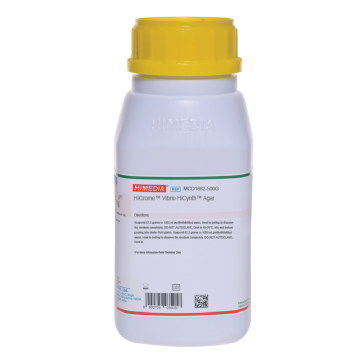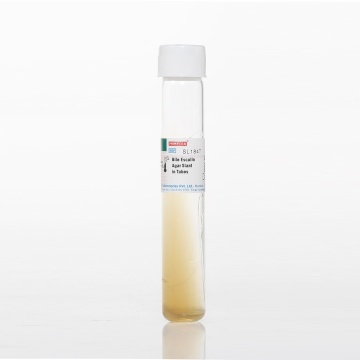 Your enquiry has been submitted
Your enquiry has been submitted
HiCrome™ Vibrio Agar
Intended use
Recommended for isolation and selective chromogenic differentiation of Vibrio species from seafood and clinical samples.
Composition**
| Ingredients | g / L |
|---|---|
| Peptone | 10.000 |
| Sodium chloride | 25.000 |
| Sodium thiosulphate | 5.000 |
| Sodium citrate | 6.000 |
| Sodium cholate | 1.000 |
| Chromogenic mixture | 5.500 |
| Agar | 15.000 |
Final pH ( at 25°C): 8.5±0.2
**Formula adjusted, standardized to suit performance parameters
Directions
Suspend 67.5 gram in 1000 ml purified/distilled water. Heat to boiling to dissolve the medium completely. DO NOT AUTOCLAVE. Cool to 45-50°C. Mix well before pouring into sterile Petri plates.
Principle And Interpretation
Vibrio's have played a significant role in human history. Outbreaks of cholera, caused by Vibrio cholerae, can be traced back in time to early recorded descriptions of enteric infections. The Vibrio's have also received the attention of marine microbiologists who observed that the readily cultured bacterial population in near-shore waters and those associated with fish and shell fish were predominantly Vibrio species (1). Vibrio species are mainly responsible for causing cholera and food poisoning in humans. Vibrio cholerae causes cholerae due to the intake of contaminated food such as raw oysters. Vibrio parahaemolyticus is a major cause of food borne infections, causing food poisoning (2). Since Vibrio species naturally occur in sea water, worth special mention is their need for sodium chloride, although some species can grow with minimum sodium chloride concentration (1). The widely used media for Vibrio isolation are TCBS Agar and Alkaline Peptone Water (3). However accompanying sucrose-fermenting bacteria pose a problem in the identification of Vibrio species on TCBS Agar. On HiCrome™ Vibrio Agar, the colour development by Vibrio species in not affected by the presence of colonies of other bacteria. This is because, the amount of colour developed depends on the reaction of the bacterial beta-galactosidase with the substrate contained in the media (4).
Peptone provides carbonaceous, nitrogenous and essential nutrients to the organisms. High concentration of sodium chloride in addition to maintaining the osmotic equilibrium also has an inhibitory action on the accompanying microflora. Sodium thiosulphate, sodium citrate and sodium cholate are used in the formulation because they can inhibit the growth of gram positive and some gram negative bacteria, but not members of Enterobacteriaceae. The proprietary chromogenic mixture incorporated in the medium helps in the chromogenic differentiation of Vibrio cholerae and Vibrio parahaemolyticus. The high (alkaline) pH of the medium helps in selective isolation of Vibrio species.
Type of specimen
Clinical samples- faeces; Food samples.
Specimen Collection and Handling
For clinical samples follow appropriate techniques for handling specimens as per established guidelines (5,6). For food samples, follow appropriate techniques for sample collection and processing as per guidelines (7). After use, contaminated materials must be sterilized by autoclaving before discarding.
Warning and Precautions
In Vitro diagnostic Use. For professional use only. Read the label before opening the container. Wear protective gloves/protective clothing/eye protection/ face protection. Follow good microbiological lab practices while handling specimens and culture. Standard precautions as per established guidelines should be followed while handling clinical specimens. Safety guidelines may be referred in individual safety data sheets.
Limitations
- Being highly selective, some species may show poor growth due to nutritional variations.
- Slight colour variation may be observed depending upon strains.
- Further biochemical tests must be carried out for confirmation.
Performance and Evaluation
Performance of the medium is expected when used as per the direction on the label within expiry period when stored at the recommended temperature.
Quality Control
Appearance: Light yellow to light tan homogeneous free flowing powder
Gelling: Firm,comparable with 1.5% Agar gel
Colour and Clarity of prepared medium: Light yellow coloured, clear to slightly opalescent gel forms in Petri plates
Reaction: Reaction of 6.75% w/v aqueous solution at 25°C. pH : 8.5±0.2
pH: 8.30-8.70
Cultural Response: Cultural characteristics observed after an incubation at 35-37°C for 18-24 hours.
| Organism | Inoculum (CFU) | Growth | Recovery | Colour of colony |
|---|---|---|---|---|
| Vibrio cholerae ATCC 15748 | 50-100 | good-luxuriant | >=50% | purple |
| Vibrio vulnificus ATCC 29306 | 50-100 | good-luxuriant | >=50% | light purple to purple |
| Vibrio parahaemolyticus ATCC 17802 (00037*) | 50-100 | good-luxuriant | >=50% | bluish green |
| Enterococcus faecalis ATCC 29212 (00087*) | >=104 | inhibited | 0% | |
| Escherichia coli ATCC 25922 (00013*) | >=104 | inhibited | 0% | |
| Staphylococcus aureus subsp. aureus ATCC 25923 (00034*) | >=104 | inhibited | 0% |
Key : *Corresponding WDCM numbers.
Storage and Shelf Life
Store between 15-25°C in a tightly closed container and the prepared medium at 2-8°C. Use before expiry date on the label. On opening, product should be properly stored dry, after tightly capping the bottle in order to prevent lump formation due to the hygroscopic nature of the product. Improper storage of the product may lead to lump formation. Store in dry ventilated area protected from extremes of temperature and sources of ignition Seal the container tightly after use. Product performance is best if used within stated expiry period.
Disposal
User must ensure safe disposal by autoclaving and/or incineration of used or unusable preparations of this product. Follow established laboratory procedures in disposing of infectious materials and material that comes into contact with clinical sample must be decontaminated and disposed of in accordance with current laboratory techniques (5,6).
Reference
- Thompson et al (ed.). 2006. The Biology of Vibrios, ASM Press, chapter 1, pg 3.
- Alcamo. E.I, 2001. Fundamentals of Microbiology, 6th ed, Jones and Bartlett Publishers, Inc. pg 254, 244.
- Clesceri, Greenberg and Eaton (ed.). 1998. Standard Method for the examination of Water and Waste water, 20th ed. American Public Health Association, Washington, D. C.
- Kudo. H. Y et al, 2001. Improved Method for Detection of Vibrio parahaemolyticus in Seafood. ASM. Vol 67, No.12, pg 5819-5823.
- Isenberg, H. Clinical Microbiology Procedures Handbook 2nd Edition.
- Murray P. R., Baron J. H., Pfaller M. A., Jorgensen J. H. and Yolken R. H., (Eds.), 2003, Manual of Clinical Microbiology, 8th Ed., American Society for Microbiology, Washington, D.C.
- Salfinger Y., and Tortorello M.L., 2015, Compendium of Methods for the Microbiological Examination of, Foods, 5th Ed., American Public Health Association, Washington, D.C.
| Product Name | HiCrome™ Vibrio Agar |
|---|---|
| SKU | M1682 |
| Product Type | HiCrome™ |
| Physical Form | Powder |
| Origin | Animal |
| Packaging type | HDPE |
| References | 1.Alcamo. E.I, 2001. Fundamentals of Microbiology, 6th ed, Jones and Bartlett Publishers, Inc. pg 254, 244.2.Clesceri, Greenberg and Eaton (ed.). 199 |
| Customized Product Available | No |









